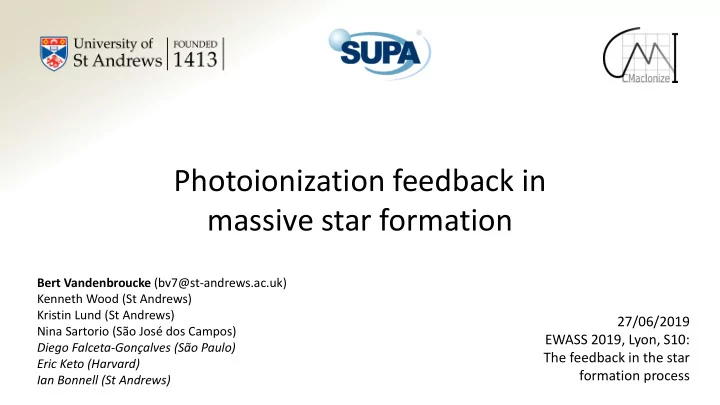

Photoionization feedback in massive star formation Bert Vandenbroucke (bv7@st-andrews.ac.uk) Kenneth Wood (St Andrews) Kristin Lund (St Andrews) 27/06/2019 Nina Sartorio (São José dos Campos) EWASS 2019, Lyon, S10: Diego Falceta-Gonçalves (São Paulo) The feedback in the star Eric Keto (Harvard) formation process Ian Bonnell (St Andrews)
Slide 2 of 14 Massive stars 𝑁 ⋆ > 100 M ⊙ https://en.wikipedia.org/wiki/Initial_mass_function https://en.wikipedia.org/wiki/List_of_most_massive_stars
Slide 3 of 14 Massive stars (2) Massive stars join the main sequence before they have reached their final mass! fusion accretion Palla & Stahler (1993) Keto (2003)
Slide 4 of 14 Photoionization Very massive stars emit copious amounts of photoionizing radiation that heats their environment cold, neutral gas hot, ionised gas Vandenbroucke & Sartorio ( in prep. )
Slide 5 of 14 Photoheating: D-type expansion Photoheating causes an outward moving shock that shuts down accretion Image courtesy of N. Sartorio Bisbas et al. (2015), STARBENCH
Slide 6 of 14 However... Gravity can trap an HII region: accretion continues for longer Image courtesy of N. Sartorio Mestel (1954), Keto (2002,2003)
Slide 7 of 14 Trapped HII regions Lund et al. (2019) See Vandenbroucke et al. (2019) for an analytic expression
Slide 8 of 14 Not as stable as we thought... Small density perturbations lead to a periodic disturbance of the ionization front Vandenbroucke et al. (2019)
Slide 9 of 14 From trapped to expanding Transition from trapped HII region to D-type expansion past the ionised sonic point Lund et al. (2019) Keto (2002)
Slide 10 of 14 Non-spherical case Angular momentum conservation leads to the formation of an accretion torus with a different density structure Sartorio et al. (2019)
Slide 11 of 14 D-type expansion in torus Sartorio et al. (2019)
Slide 12 of 14 Trapped HII regions Non-spherical trapped and semi-trapped Sartorio et al. (2019) HII regions also possible
Slide 13 of 14 Critical luminosity Sartorio et al. (2019)
Slide 14 of 14 Summary • Spherical HII regions grow as the mass (and luminosity) increases => accretion shuts down • Non-spherical HII regions are embedded in an accretion torus: – can keep accreting through torus plane – torus structure changes with mass; unclear if evolution from trapped to D-type expansion still possible – stable accretion only possible for dense torus
Recommend
More recommend